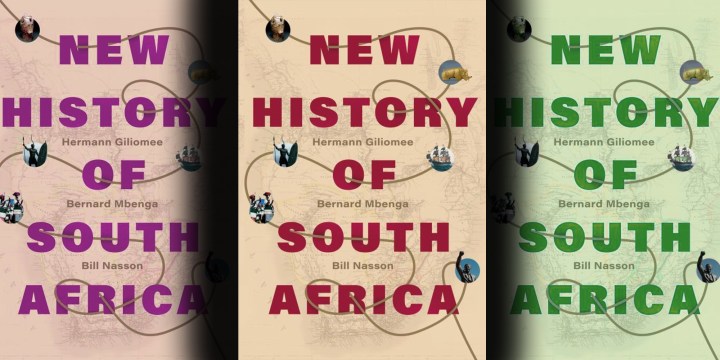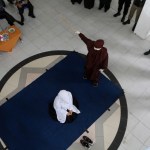BOOK EXTRACT
New History of South Africa – how the Mfecane transformed the political landscape of southern Africa

This newly updated, comprehensive history of South Africa presents the country’s turbulent history in a fresh, readable narrative. Grippingly retold by leading historians and scholars under the editorship of Hermann Giliomee, Bernard Mbenga and Bill Nasson, ‘New History of South Africa’ starts with recent discoveries about the origin of humanity in Africa. It is published by Tafelberg.
The Mfecane: A time of trouble and rapid transformation
For most African societies in South Africa, the hallmarks of the nineteenth century were difficulty, conflict, dislocation, reorganisation and finally subjugation. The appearance of the Griqua north of the Orange River heralded the imminent arrival of European styles of life, war and government. Before the full impact of this was experienced, however, most communities were subjected to the vagaries and hardships of the Mfecane.
Literal translations of this term show up assumptions about the Mfecane “concept”. In older historical works it was a time of “convulsions”, of “crushing” and of “wandering hordes”, initiated almost solely by Shaka and the Zulu. But new interpretations have identified new suspects: Europeans at the Cape and Delagoa Bay; European surrogates such as the Griqua on the highveld. Historians are divided as to the causes, but the events constituting the term Mfecane reshaped the political landscape of southern Africa.
During the last half of the eighteenth century and the first quarter of the nineteenth, dramatic developments transformed the nature of African societies, and altered the demographic shape of South Africa. These have been referred to as the Mfecane (for Nguni speakers) and Difaqane (for Sotho-Tswana speakers) on the highveld. Before the 1970s, scholars generally thought that these changes derived from the growth of the Zulu kingdom under Shaka in southeast Africa, and that the changes had begun to occur at the end of the eighteenth century. Since the early 1990s such views have been modified. It is now accepted that the Zulu were by no means the only ones responsible for the warfare that spread throughout the southeast African coastal areas and the inland regions.
Now it is generally recognised that other African chiefdoms responded just as vigorously and innovatively to the changing conditions of the late eighteenth century. The geographic focus of the process has been expanded to include the interior of South Africa, and the beginning of the Mfecane has been extended backwards from about the 1790s to the mid-eighteenth century. Geographically, the sphere of the Mfecane has now been broadened to include communities of the entire western highveld.
Nor was the conflict exclusively one between Africans. It has been argued that increasing European penetration into South Africa from the Cape and Mozambique destabilised the African communities along the coast and into the interior. Historians are more divided, however, over the degree to which whites are responsible for the commotions of the Mfecane.
How did the Mfecane begin?
To understand this transformation it is necessary to pose three straightforward questions, which to some extent belie their complexity. How did the Mfecane begin? Why did it occur? And what were its consequences?
The discussion begins by tracing developments in the present area of KwaZulu-Natal on the southeastern seaboard. From 1780, in the territory from Delagoa Bay to the Thukela (Tugela) River, a number of African chiefdoms began to expand in size and grow in power. These included the Mabhudu and Tembe, under Makhasane, near the coast. Weaker communities were dominated or expelled from the region. Even the nascent Pedi kingdom, some 300 kilometres away in the interior, felt the effects of this.
Further south, a similar pattern emerged, with the Ndwandwe and Mthethwa chiefdoms increasing their numbers and competing for allies. This led groups some distance away from these expanding chiefdoms to strengthen their military capabilities – including the Hlubi in the Drakensberg foothills, and the Qwabe below the Thukela River.
Read in Daily Maverick: “The story of an Mfecane mega-drought is written in the trees”
Some chiefdoms caught up in the conflict between these competing power blocs chose to flee. The Ngwane under Matiwane’s leadership moved westwards, attacking the Hlubi and killing their chief, Mthimkhulu. The Hlubi split apart; some abandoned their homeland and others merged with the Ngwane. Chief Matiwane settled in the region of modern Bergville, incorporating smaller groups such as the Zizi and Bhele. He was now the dominant figure in the upper Thukela.
After 1810, Dingiswayo of the Mthethwa surrounded himself with allies and forced those who refused to join him into tributary status. One of these confederates was the Zulu. When their chief Senzangakhona died, Dingiswayo intervened and appointed Shaka as leader.
By 1818 the rivalry for power in the region between the Mthethwa and the Ndwandwe under Zwide was reaching a climax. The Ndwandwe resided in present-day northern Zululand and, like Dingiswayo, Zwide commanded the loyalty of a number of smaller chiefdoms. A difference between them was that the Mthethwa built loyalties around common trade interests in cattle and ivory, while the Ndwandwe seemed to rely on the support of related communities.
In 1818, Dingiswayo was captured by Zwide and killed. This allowed Shaka to step into the power vacuum and take control of the Mthethwa. Zwide then turned his attention to the Zulu, seeing them as the only ones capable of thwarting his control over the former Mthethwa confederacy. But Shaka had managed to weld his neighbours into an alliance against the Ndwandwe. These included the powerful Qwabe chiefdom, which previously had rivalled the Zulu for dominance between the White Mfolozi and Thukela rivers.
Zwide’s first attack against the Zulu was inconclusive, but in another raid his troops overstretched themselves, driving far into the Thukela River region. Shaka’s army forced the Ndwandwe into headlong flight. The Ndwandwe, in all likelihood already experiencing internal stress, disintegrated.
Soshangane and Zwangendaba of the Jele and Gaza chiefdoms, who were principal allies of Zwide, moved first to the Delagoa Bay region and then later trekked north. Zwide himself attempted to regroup north of the Phongolo River.
Read in Daily Maverick: “Back to the future: South Africa’s battle with its past”
The Zulu then took steps to secure their position in the region across the White Mfolozi and southwards along the lower Thukela and Mzinyathi rivers. This represented a consolidation of existing territorial gains. Contrary to popular historical conceptions, the Zulu kingdom did not have the capacity to extend its sway to the Delagoa Bay (near present-day Maputo) region. Nor was it immediately secure to its south. After defeating Macingwane, the powerful chief of the Chunu, Shaka was able to manoeuvre client chiefs such as Magaye of the Cele and Zihandlo of the Mkhize into positions of power and so protect his southern border.
The turmoil spreads
To the north, Soshangane eventually established himself along the Nkomati River. He gathered his followers and migrated into southern Mozambique to form the Gaza kingdom.
Zwangendaba and Nxaba, leaders of other factions of the Ndwandwe, moved across the Zambezi into what is today eastern Zimbabwe, and from here to present-day eastern and western Zambia, central Malawi and southern Tanzania. Zwide, seeking greater security, moved into what is today central Eswatini, where he managed to attract more followers from weaker chiefdoms. He died in about 1824 and two years later Shaka launched a massive attack on Zwide’s son.
At a battle north of the Phongolo River the Ndwandwe were heavily defeated. They splintered; some joined Soshangane, others were absorbed into the Zulu kingdom and others joined the other rising power in the region – the Ndebele. The Ndebele, led by Mzilikazi, were from the Khumalo clan, situated between the Zulu and Ndwandwe. To avoid involvement in this growing competition between his neighbours, Mzilikazi chose to move away. The date of this migration is uncertain: by 1825 he was settled along the Vaal River and then moved north to the Apies River.
Some accounts suggest he attacked the Pedi, a very powerful polity. A few years later the Ndebele were to destabilise – and then control – a huge region on the western highveld. ML/DM
Hermann Giliomee is an internationally renowned historian. His bestselling Die Afrikaners was adapted into a documentary for kykNET in 2018, while the original English, The Afrikaners, was published to acclaim here and in the US and UK. He has been an associate at Yale, Cambridge and the Wilson Centre for International Scholars in Washington DC.
Dr Bernard Mbenga was head of the history department at the University of Northwest. He is co-editor and co-author of the Cambridge History of South Africa, Vol.1, c.200 AD to 1886 AD. He served on the editorial boards of the South African Historical Journal, The Journal of African History and the online ejournal History Compass.
Bill Nasson is an emeritus professor of history, previously at the universities of Cape Town and Stellenbosch. He has held visiting fellowships at the University of Cambridge, the Australian National University, Yale and the University of Illinois. He is the award-winning author of numerous books and a past editor of The Journal of African History.



















 Become an Insider
Become an Insider
Comments - Please login in order to comment.